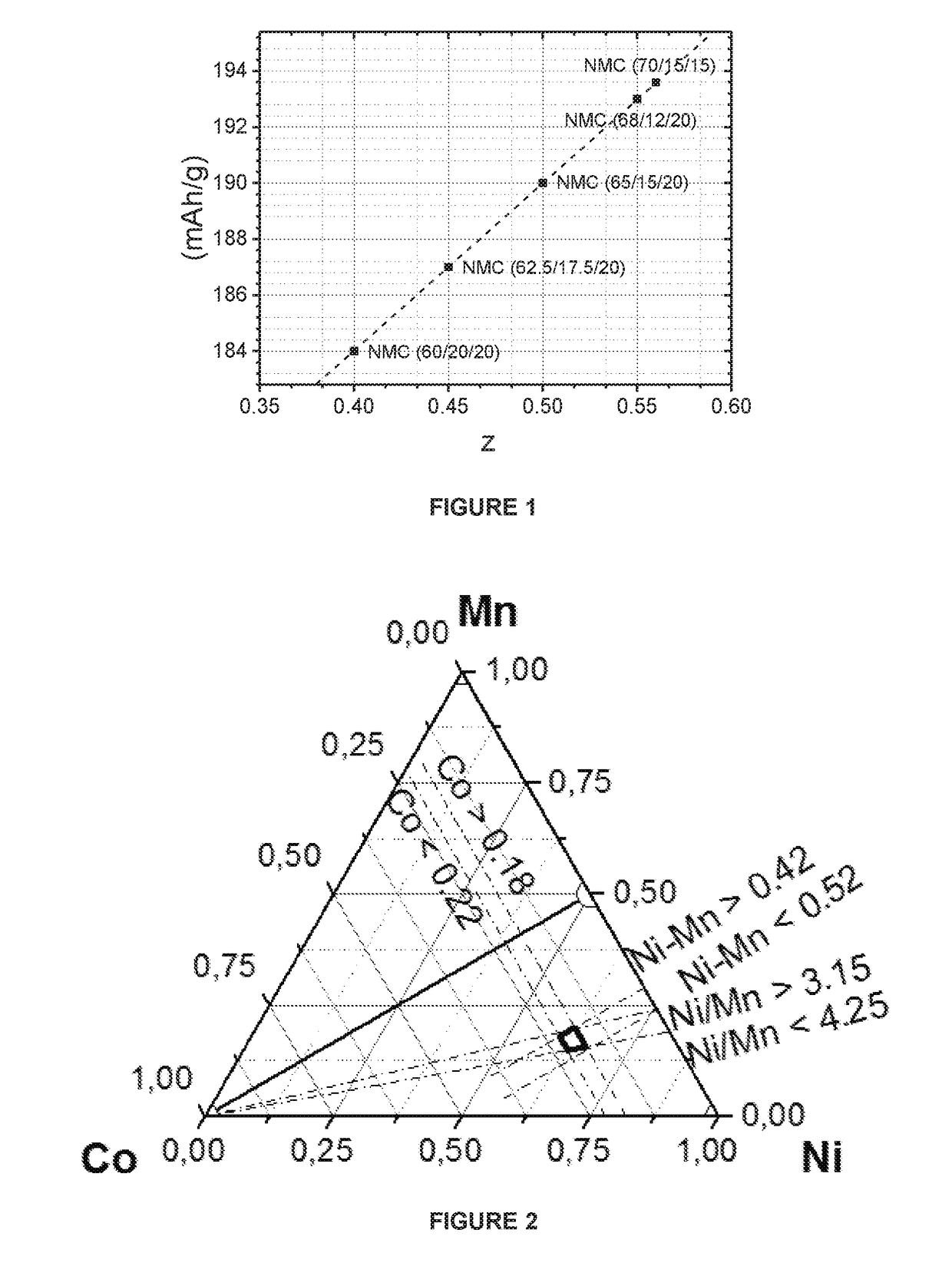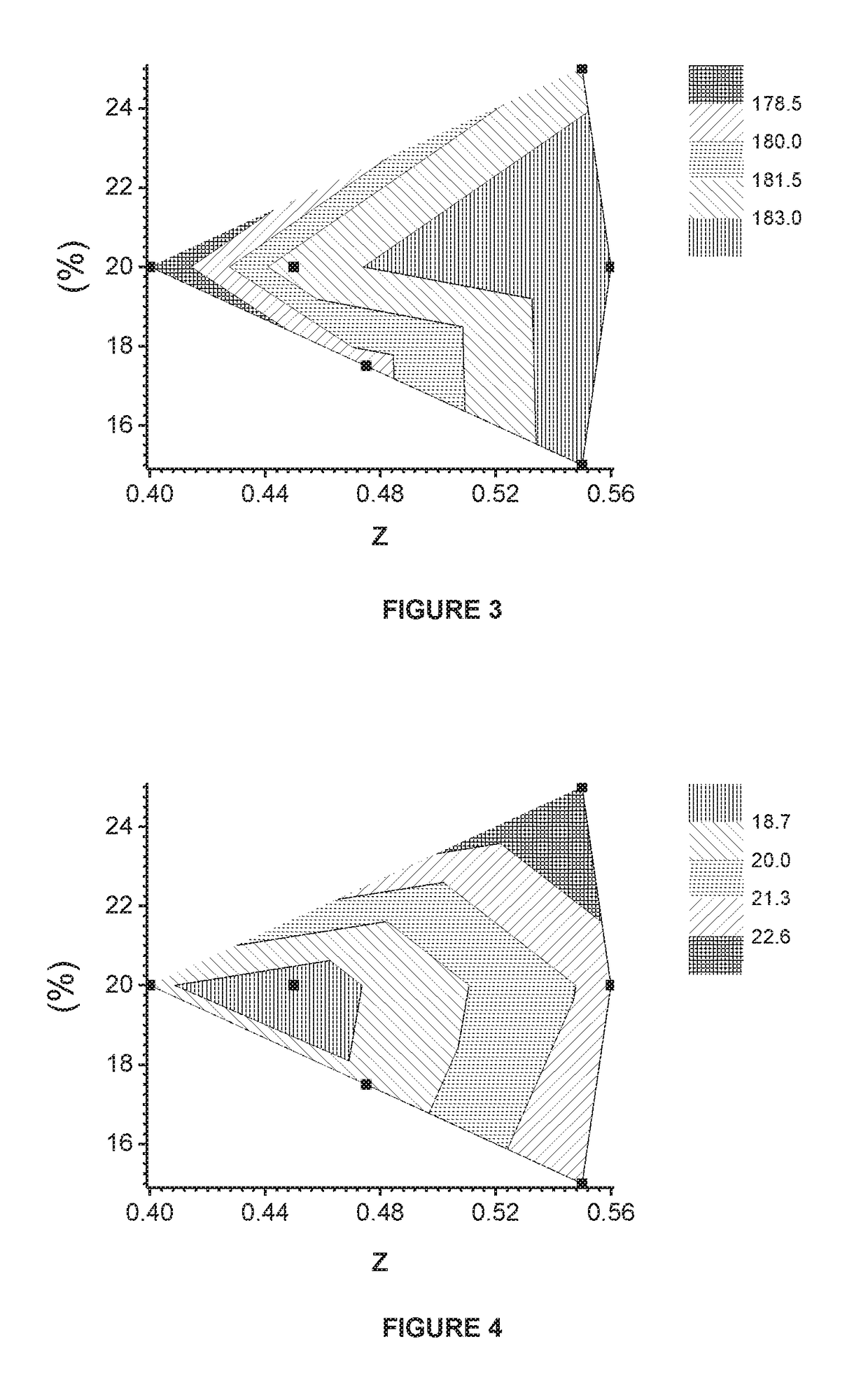Ni based cathode material for rechargeable lithium-ion batteries
a lithium-ion battery and cathode material technology, applied in nickel compounds, alkali metal sulfites/sulfates, cell components, etc., can solve the problems of very slow decomposition, small cosub>2 /sub>equilibrium partial pressure of very high ni-excess cathode materials, and increase production difficulty. , to achieve the effect of improving battery performance, excellent high capacity and long cycle stability
- Summary
- Abstract
- Description
- Claims
- Application Information
AI Technical Summary
Benefits of technology
Problems solved by technology
Method used
Image
Examples
example 1
[0102]Sample EX1.1 is prepared according to the above-mentioned “Manufacturing Example”. A mixed nickel-manganese-cobalt hydroxide (M′(OH)2) is used as a precursor, where M′(OH)2 is prepared by a co-precipitation process in a large-scale continuous stirred tank reactor (CSTR) with mixed nickel-manganese-cobalt sulfates, sodium hydroxide and ammonia. In the 1st blending step, 5.5 kg of the mixture of M′(OH)2, wherein M′=Ni0.625Mn0.175Co0.20 (Ni-excess=0.45), and LiOH.H2O with Li / M′ ratio of 0.85 is prepared. The 1st blend is sintered at 800° C. for 10 hours under an oxygen atmosphere in a chamber furnace. The resultant lithium deficient sintered precursor is blended with LiOH.H2O in order to prepare 50 g of the 2nd blend of which Li / M′ is 1.01. The 2nd blend is sintered at 840° C. for 10 hours under the dry air atmosphere in a chamber furnace. The above prepared EX1.1 has the formula Li1.005M′0.995O2 (Li / M′=1.01).
[0103]EX1.2, which has the formula Li0.975M′1. 025O2 (Li / M′=0.95), is p...
example 2
[0116]EX2.1, which is an industrial scale product, is prepared according to the above-mentioned “Manufacturing Example”. A mixed nickel-manganese-cobalt hydroxide (M′(OH)2) is used as a precursor, where M′(OH)2 is prepared by a co-precipitation process in a large-scale continuous stirred tank reactor (CSTR) with mixed nickel-manganese-cobalt sulfates, sodium hydroxide and ammonia. In the 1St blending step, 5.5 kg of the mixture of M′(OH)2, wherein M′=Ni0.625Mn0.175Co0.20 (Ni-excess=0.45), and Li2CO3 with Li / M′ ratio of 0.8 is prepared. The 1st blend is sintered at 885° C. for 10 hours under the dry air atmosphere in a chamber furnace. The resultant lithium deficient sintered precursor is blended with LiOH.H2O in order to prepare 4.5 kg of the 2nd blend of which Li / M′ is 1.045. The 2nd blend is sintered at 840° C. for 10 hours in a dry air atmosphere in a chamber furnace. The above prepared EX2.1 has the formula Li1.022M′0.978O2 (Li / M′=1.045).
[0117]EX2.2, which is an aluminum coated ...
PUM
 Login to View More
Login to View More Abstract
Description
Claims
Application Information
 Login to View More
Login to View More - R&D
- Intellectual Property
- Life Sciences
- Materials
- Tech Scout
- Unparalleled Data Quality
- Higher Quality Content
- 60% Fewer Hallucinations
Browse by: Latest US Patents, China's latest patents, Technical Efficacy Thesaurus, Application Domain, Technology Topic, Popular Technical Reports.
© 2025 PatSnap. All rights reserved.Legal|Privacy policy|Modern Slavery Act Transparency Statement|Sitemap|About US| Contact US: help@patsnap.com



